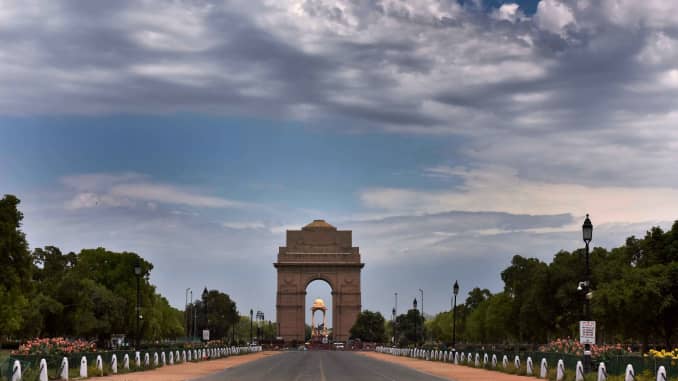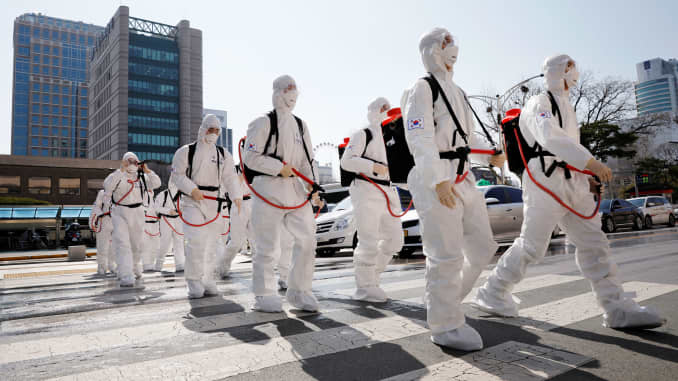“Coronavirus lockdowns have led to an unprecedented fall in air pollution for these major cities”, CNBC
Sam Meredith, Sustainable Energy, Apr 22, 2020
KEY POINTS
- IQAir, a Swiss-based air quality technology company, compared measurements of the world’s deadliest air pollutants before and during the Covid-19 outbreak in 10 major cities across the globe.
- The findings, published Wednesday on Earth Day, revealed a “drastic drop” in air pollution for almost all of the cities under lockdown when compared with a year earlier.
- New Delhi recorded a 60% fall of PM2.5 compared with 2019 levels, Seoul registered a 54% drop, while the fall in China’s Wuhan came in at 44%.

Confinement measures imposed to slow the spread of the coronavirus pandemic have resulted in an unprecedented fall of deadly air pollutants around the world, according to new research published on Earth Day.
IQAir, a Swiss-based air quality technology company, compared measurements of the world’s deadliest air pollutant — “fine particulate matter” known as PM2.5 — before and during the Covid-19 outbreak in 10 major cities.
The findings, published Wednesday, revealed a “drastic drop” in air pollution for almost every city under lockdown when compared with the same period a year earlier.
New Delhi recorded a 60% fall of PM2.5 from 2019 levels, Seoul registered a 54% drop, while the fall in China’s Wuhan came in at 44%.
The study also found that Wuhan experienced its cleanest air quality on record through February and March, while Los Angeles experienced its longest-ever stretch of clean air — meeting the United Nation’s recommended air quality guidelines.
The data was based on a three-week time frame to reflect either the most stringent lockdown measures in each city or to coincide with the peak number of daily reported Covid-19 infections.
Major cities with historically higher levels of deadly air pollutants witnessed the most substantial drop in PM2.5, the analysis found.
Two global public health crises
PM2.5 is smaller than 2.5 micrometers in diameter and is widely regarded as the pollutant that poses the greatest threat to health of all commonly measured air pollutants.
Its small size means the particulate matter can penetrate deep into the human respiratory system and the bloodstream, IQAir researchers said, potentially causing a wide range of short- and long-term health effects.
Air pollution is already a global public health crisis. It kills an estimated 7 million people worldwide every year, according to the World Health Organization, with 9 of 10 people thought to be breathing air containing high levels of pollutants.

The Covid-19 outbreak has meant countries around the world have effectively had to shut down, with many governments imposing draconian restrictions on the daily lives of billions of people. It has created an extraordinary demand shock in energy markets, with mobility brought close to a standstill.
Confinement measures have been implemented in 187 countries or territories in an effort to try to slow the pandemic.
The IQAir analysis studied the air quality in 10 major global cities under coronavirus lockdown: New Delhi, London, Los Angeles, Milan, Mumbai, New York, Rome, Sao Paulo, Seoul and Wuhan.
Rome bucks the trend for air quality
New Delhi regularly tops the world’s most polluted city lists. But as well as a significant drop in pollutants, the IQAir data showed that the number of hours that air quality in the city was rated as “unhealthy” during the initial three-week lockdown period dropped to 17% in 2020, from 68% a year earlier.
Of all of the cities studied, only Rome recorded a higher number of PM2.5 over a three-week period of coronavirus lockdown in 2020 when compared with 2019 levels.

The city recorded a 30% increase in particle pollution, despite an increase in the number of hours that met WHO guidelines. The study noted that domestic heating was a “significant source” of air pollution in Rome from November through to April and increased reliance on residential heating systems could be behind these findings.